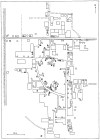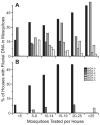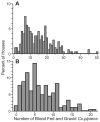A critical appraisal of molecular xenomonitoring as a tool for assessing progress toward elimination of Lymphatic Filariasis
- PMID: 17978055
- PMCID: PMC2196407
A critical appraisal of molecular xenomonitoring as a tool for assessing progress toward elimination of Lymphatic Filariasis
Abstract
We used molecular xenomonitoring (MX, detection of filarial DNA in mosquitoes) to evaluate the impact of mass drug administration (MDA) in sentinel locations in Egypt with high (11.5%) and low (4.1%) baseline microfilaria prevalence rates. Blood-fed Culex pipiens were pooled by household and tested for Wuchereria bancrofti DNA by PCR. There was no significant relationship between the infection status of household residents and parasite DNA status of mosquitoes from the same houses. After 5 MDA rounds, parasite DNA rates in mosquitoes in high- and low-prevalence areas were reduced by 93.8% and 100% to 0.19% (95% CI: 0.076-0.382%) and 0% (95% CI: 0-0.045%), respectively. These changes were consistent with decreases in microfilaria prevalence rates in these sites; they provide insight regarding the minimal mosquito DNA rates necessary for sustained transmission of filariasis in Egypt. We conclude that MX is a powerful tool for monitoring the impact of MDA on filariasis endemicity and transmission.
Figures




Similar articles
-
Molecular xenomonitoring of lymphatic filariasis.Am J Trop Med Hyg. 2007 Oct;77(4):591-2. Am J Trop Med Hyg. 2007. PMID: 17978054 No abstract available.
-
Molecular xenomonitoring as a post-MDA surveillance tool for global programme to eliminate lymphatic filariasis: Field validation in an evaluation unit in India.PLoS Negl Trop Dis. 2020 Jan 24;14(1):e0007862. doi: 10.1371/journal.pntd.0007862. eCollection 2020 Jan. PLoS Negl Trop Dis. 2020. PMID: 31978060 Free PMC article.
-
Detection of Wuchereria bancrofti in mosquitoes by the polymerase chain reaction: a potentially useful tool for large-scale control programmes.Trans R Soc Trop Med Hyg. 2001 Jan-Feb;95(1):29-32. doi: 10.1016/s0035-9203(01)90322-0. Trans R Soc Trop Med Hyg. 2001. PMID: 11280059
-
Prospects, drawbacks and future needs of xenomonitoring for the endpoint evaluation of lymphatic filariasis elimination programs in Africa.Trans R Soc Trop Med Hyg. 2016 Feb;110(2):90-7. doi: 10.1093/trstmh/trv104. Trans R Soc Trop Med Hyg. 2016. PMID: 26822601 Review.
-
Elimination of lymphatic filariasis as a public health problem from the Arab Republic of Egypt.Acta Trop. 2019 Nov;199:105121. doi: 10.1016/j.actatropica.2019.105121. Epub 2019 Aug 7. Acta Trop. 2019. PMID: 31400299 Review.
Cited by
-
Xenomonitoring of different filarial nematodes using single and multiplex PCR in mosquitoes from Assiut Governorate, Egypt.Korean J Parasitol. 2015 Feb;53(1):77-83. doi: 10.3347/kjp.2015.53.1.77. Epub 2015 Feb 27. Korean J Parasitol. 2015. PMID: 25748712 Free PMC article.
-
Molecular xenomonitoring of diurnally subperiodic Wuchereria bancrofti infection in Aedes (Downsiomyia) niveus (Ludlow, 1903) after nine rounds of Mass Drug Administration in Nancowry Islands, Andaman and Nicobar Islands, India.PLoS Negl Trop Dis. 2020 Oct 23;14(10):e0008763. doi: 10.1371/journal.pntd.0008763. eCollection 2020 Oct. PLoS Negl Trop Dis. 2020. PMID: 33095805 Free PMC article.
-
Comparison of collection methods for Phlebotomus argentipes sand flies to use in a molecular xenomonitoring system for the surveillance of visceral leishmaniasis.PLoS Negl Trop Dis. 2023 Sep 1;17(9):e0011200. doi: 10.1371/journal.pntd.0011200. eCollection 2023 Sep. PLoS Negl Trop Dis. 2023. PMID: 37656745 Free PMC article.
-
Epidemiological and entomological evaluations after six years or more of mass drug administration for lymphatic filariasis elimination in Nigeria.PLoS Negl Trop Dis. 2011 Oct;5(10):e1346. doi: 10.1371/journal.pntd.0001346. Epub 2011 Oct 11. PLoS Negl Trop Dis. 2011. PMID: 22022627 Free PMC article.
-
Assessing the presence of Wuchereria bancrofti in vector and human populations from urban communities in Conakry, Guinea.Parasit Vectors. 2015 Sep 26;8:492. doi: 10.1186/s13071-015-1077-x. Parasit Vectors. 2015. PMID: 26410739 Free PMC article.
References
-
- World Health Organization. Global program to eliminate lymphatic filariasis. Wkly Epidemiol Rec. 2006;81:221–232. - PubMed
-
- World Health Organization. Elimination of lymphatic filariasis as a public health problem—resolution of the executive board of the WHO. 50th World Health Assembly; May 6, 1997; Geneva, Switzerland. Geneva: WHO; 1997. p. WHA 50.29.
-
- Ottesen EA, Ismail MM, Horton J. The role of albendazole in programmes to eliminate lymphatic filariasis. Parasitol Today. 1999;15:382–386. - PubMed
-
- Gad AM, Riad IM, Farid HA. Host-feeding patterns of Culex pipiens and Culex antennatus (Diptera: Culicidae) from a village in Sharqiya Governorate, Egypt. J Med Entomol. 1995;32:573–577. - PubMed
-
- World Health Organization. Defining the roles of vector control and xenomonitoring in the global programme to eliminate lymphatic filariasis; Report of the informal consultation WHO/HQ; Geneva. 29–31 January 2002; Geneva: WHO; 2002. p. 42. WHO/CDS/CPE/PVC/2002.3.
Publication types
MeSH terms
Substances
Grants and funding
LinkOut - more resources
Full Text Sources
